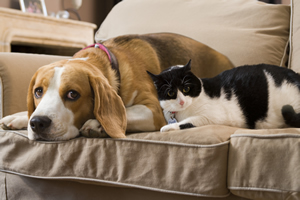News
Thyroid disease – is your pet affected?
by on January 4th, 2013
Category: News, Tags:
 Most of us have heard of the thyroid gland, but did you know that thyroid problems are surprisingly common in pets?
Most of us have heard of the thyroid gland, but did you know that thyroid problems are surprisingly common in pets?
The thyroid gland which consists of two lobes, located on either side of the trachea (windpipe) in the neck, produces thyroid hormone which regulates your pet’s metabolic rate. Too much thyroid hormone speeds up the body’s metabolism, whilst too little slows it down.
Hyperthyroidism in cats
Over production of thyroid hormone is called hyper-thyroidism and is a relatively common condition in cats over eight years of age. In the majority of cases this is caused by benign (non-cancerous) enlargement of one or both thyroid lobes. Hyperthyroid cats typically have an increased appetite, but despite this show signs of weight loss, and often become quite unkempt in appearance. In addition, excess thyroid hormone usually increases the heart rate, frequently causing cardiac problems. As well as the above, a variety of other signs may be seen including hyperactivity, vomiting and diarrhoea. However the good news is that in the majority of cases, hyperthyroidism can be successfully treated. If you are concerned your cat may be hyperthyroid, come and see us for a check-up.
Hypothyroidism in dogs
Under production of thyroid hormone is called hypothyroidism, and is a relatively common condition in the older dog. Lowered production of thyroid hormone leads to a decrease in the metabolic rate, usually leading to weight gain (with no increased appetite) and generalised lethargy. Other signs often include coat problems, and recurrent skin and ear infections. Diagnosis of hypothyroidism can be tricky, but in confirmed cases, daily treatment with oral thyroid supplements will be very successful in treating this condition.
As you can see, thyroid conditions are relatively common in pets, but the really good news is that with an appropriate diagnosis, both conditions are very treatable. Please don’t hesitate to contact us if you are concerned that your pet is showing any of the signs described above.
You can leave a response, or trackback from your own site.
